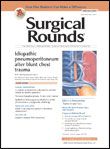Calcified Aortic Valves: Laser Options in the Works
Symptomatic severe aortic valve stenosis reduces life expectancy and prompts the need for aortic valve replacement, which can be done 2 ways.

Symptomatic severe aortic valve stenosis reduces life expectancy and prompts the need for aortic valve replacement (AVR). Usually, patients are elderly and often have comorbidities. Research indicates that around 16% of patients need a pacemaker after surgery.
Surgeons use 2 procedures to perform AVR: the standard AVR via median sternotomy with cardiopulmonary bypass during cardioplegic arrest, or transcatheter aortic valve implantation (TAVI) in patients ineligible for conventional AVR.
TAVI does not resect the patients’ calcified aortic valve, but squeezes it between the aortic wall and the transcatheter valve. Potential complications include paravalvular leakage, the need for a pacemaker, and ostial coronary occlusion. Squeezing the aortic valve causes uncontrolled movement of the calcified aortic leaflets, which may be responsible for the complications. Surgeons are constantly looking for better resection tools that would be minimally invasive and reduce adverse events.
In a study published in the July/August issue of Innovations, researchers describe their ex vivo resection tools for human calcified aortic valves.
The researchers employed 12 human calcified aortic leaflets, and investigated laser scalpel, a punching device, and scissors for cross-section morphology. They evaluated the cutting surface area using scanning electron microscopy and histological analyses.
Compared to scissors and punching devices, the Excimer laser scalpel resulted in smoother, more regular, and uniform cross-section areas. In quantitative analysis of the cutting edges, the various resection tools performed significantly differently. The laser scalpel yielded the best results, and the scissors and punching devices were quite similar but more rudimentary.
This technology is not yet approved for clinical use. The authors note that partial or complete transcatheter aortic valve resection before TAVI might improve patient outcomes.
An important question — whether laser-cut surfaces improve tissue ingrowth compared to mechanical resection methods — will need to be resolved before this process can move into the operating suite. Specifically, research needs to determine if the remaining ring of native aortic tissue after partial aortic valve resection is sufficiently stable to anchor the transcatheter valve. Additionally, a protection device will be needed to minimize the risk for embolization of leaflet debris.
